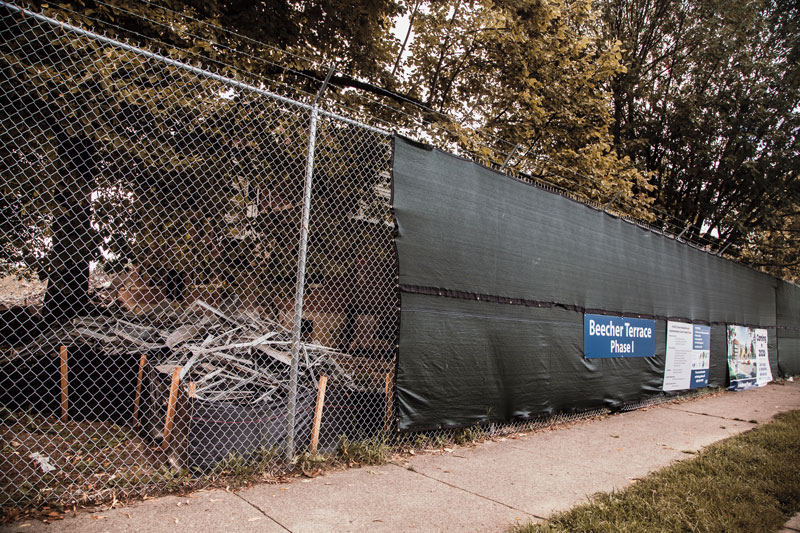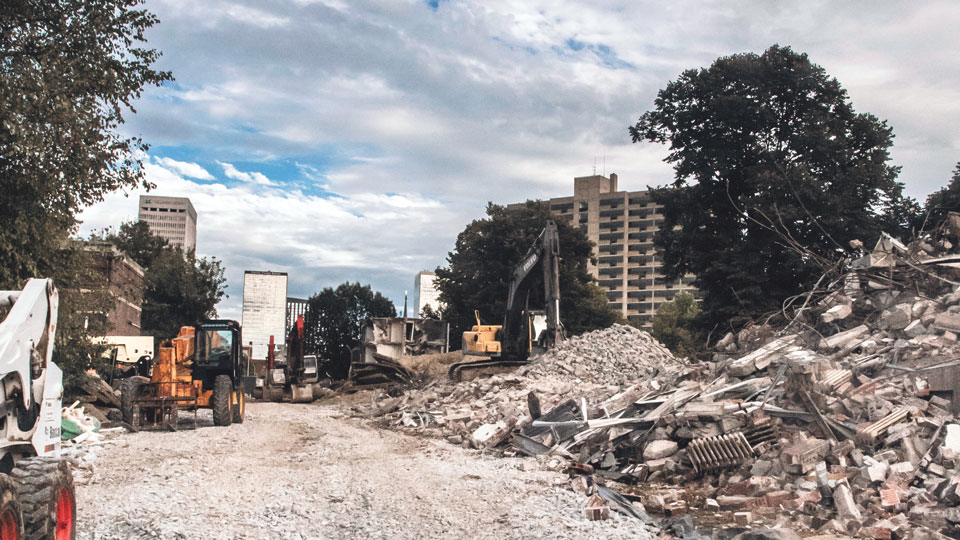There’s no mistaking, no mutating Jackie Floyd’s love of Russell. It began about 30 years ago when she moved to the neighborhood. And now, somewhere in her 65-year-old heart, the rectangle bounded by Broadway and 32nd, Ninth and Market streets remains latched for life. “You know how people say they don’t go to the other side of Ninth Street because they get scared? When I go past Ninth, I’m like” — she exhales, her posture and shoulders softening — “I’m home. I’m coming in a community that understands me. Ninth Street wraps its arms around me and I’m safe.” She talks up her neighborhood so much that her grandkids occasionally have to remind her, “We’re going to Kroger for food, so, please, no chatting with strangers about Russell.”
If you have the time, she won’t just talk it up. She’ll lead you on a tour. On an August morning, Floyd, all energy and eager smiles that showcase her high cheekbones, starts walking and waving at neighbors who holler for her — “Hey, Miss Jackie!” An unseasonably cool breeze greets us, as does a chorus of lively cicadas gathered overhead. We head west on Muhammad Ali Boulevard, taking in the sights of the largely African-American community that’s home to about 9,600 people. She pauses to point out a nearly 4,000-square-foot gated brick home, one of a handful of stately houses built within the last 20 years. She pauses again at a far older, white-columned Italianate home, abandoned and boarded up. “I see the beauty in it,” she says. Floyd wants a Russell renaissance, a return to its 1940s glory when the area just west of downtown was dubbed “Louisville’s Harlem” due to its bustling Walnut Street corridor of nightclubs and shops. (Walnut Street became Muhammad Ali Boulevard.)
Change seems guaranteed. Several big projects are slated for in and around Russell, including a $264-million renovation of Beecher Terrace that will tear down the public-housing complex and replace it with new, mixed-income housing; a $28-million YMCA at 18th Street and Broadway, alongside a new $130-million Passport Health Plan headquarters; and, at 30th and Ali, a $30-million indoor track-and-field facility developed by the Louisville Urban League. Add to that ongoing investment in Portland, infrastructure improvements throughout west Louisville and a few businesses expanding or opening. Investment west of Ninth totals $867 million, a hefty sum. So much so that gentrification — the reshuffling of a neighborhood in which, often, white residents lay claim to a predominantly black neighborhood — looms as a realistic fear. “We believe this area will see an increase, a growth in prosperity. The real estate value will go up,” says Cathy Hinko, director of the Metropolitan Housing Coalition. “That is a great thing to happen. It is also a scary thing to happen. If you are one of the homeowners in the area, when is a good time to sell?”
Over the summer, the Louisville Urban League printed fliers for Russell and other west Louisville residents with the message: “Stop. Don’t Sell.” Homeowners were reporting knocks on doors, mailers and even calls on their cell phones from investors looking to buy up property before values rise. Mattie Jones, a longtime Shawnee resident and civil-rights activist, says that, a few months ago, a stranger knocked on her door. “He praised my home and said, ‘You interested in selling?’” she recalls. Jones lives in an elegant, well-preserved 100-year-old house. “I said, ‘You see a sign in my yard?’ He said, ‘No.’ I said, ‘Come back when you see one.’”

A $264-million renovation of Beecher Terrace is just one of several big projects slated for the Russell neighborhood.
Floyd rents her apartment in Russell, so her neighbors in the apartment complex have not experienced such solicitations. On this August day, as we walk, Floyd, who works for the Center for Neighborhoods, is in her element — showing off her favorite spots (“Sweet Peaches has the best food”) and thinking ahead (“I cannot wait until they turn Muhammad Ali into a two-way street!” she exclaims, referring to community-improvement plans for Russell hatched by Metro government and the Louisville Metro Housing Authority). She spots a young man and woman standing on the sidewalk. “Want to share with this reporter how great Russell is?” she cheerily asks, gesturing to me. They both shoot her a look of — You crazy?
For a moment, their reaction throws off Floyd. Hand on hip, she squints her eyes and cocks her head, puzzled, ready to listen. They say their block is OK, but it’s bad news around the corner and the farther west into Russell you go. About 60 percent of Russell’s population lives in poverty, including about 3,000 children. Median household income is about $14,500. Hundreds of vacant or abandoned homes scar the neighborhood. Floyd knows that these and other problems exist. But she’s adamant that the numbers don’t tell the whole story. “Someone might only have a 10th-grade education,” she says. “But they may still be successful in running a business, or maybe they’re a deacon in a church.” She promises the man and woman that she’ll return with fliers for upcoming neighborhood meetings. “Y’all are the future of this neighborhood,” she says, then adds with a smile: “I’m getting ready to sit down.”
That’s doubtful. Just a few nights before, Floyd stood up during a meeting at the Louisville Urban League discussing Russell’s future. First up on the agenda: a new initiative — Russell: A Place of Promise. It commits to economic, housing and investment opportunities for current Russell residents, so that they can reap the rewards of revitalization.
The initiative partners metro government with Cities United, an organization working to eliminate violence affecting African-American males across America. A pledge was made at the meeting, one that guaranteed “serious” community engagement as the project takes shape. A few minutes later, Floyd gripped the microphone. “My name is Jackie Floyd and I’m a proud Russell resident,” she said, earning applause. “We have a habit that when people say they’re going to engage the community, the plan is already set.”
Such pushback isn’t surprising. In the 1960s and ’70s, government touted urban renewal as a good thing, a way to clear out troubled urban areas. It decimated black neighborhoods. Redlining, the discriminatory practice of denying loans in certain neighborhoods based on racial and socioeconomic makeup, along with decades of disinvestment in west Louisville, left the footprint that exists today. So when Jackie Floyd and many others stand up and question the legitimacy of Russell: A Place of Promise, Anthony Smith and Theresa Zawacki, who co-lead the project, aren’t surprised at all. “All of it comes from a very honest place,” Smith says. “There are reasons for people to think ‘I’ll believe it when I see it’ or ‘There’s no way the city wants to invest in black wealth creation.’”
Launched in August, Russell: A Place of Promise is still hard to grasp, well-intentioned but intangible. “We want to make sure everyone has an opportunity to take advantage of opportunities,” is a sentiment Zawacki shares during a recent community meeting. No specific blueprint exists yet. But that’s sort of the point, say Zawacki and Smith. They want neighbors to lead the charge, to tell them what can help Russell thrive and remain a neighborhood for longtime residents as well as newcomers.
A $5-million grant from the William R. Kenan, Jr. Charitable Trust will act as seed money. Zawacki, who is temporarily leaving her position at Louisville Forward, the city’s economic-development arm, and Smith, who is director of Cities United, will lead the project for up to five years. By then, the hope is that Russell: A Place of Promise will stand as a self-sufficient, community-based organization, one that other cities could use as a model when faced with their own gentrification concerns.

Much of what happens to Russell may be hard to control, largely up to the whims of capitalism and housing trends.
The city has gifted a 200,000-square-foot former cigar factory at 30th and Madison streets (right near the proposed indoor track facility) to the project. It could wind up as a place for new commercial and residential ventures, perhaps functioning as a cooperative, Zawacki says. Smith has floated the idea of helping business owners, like barbers, buy the buildings they currently rent space in, creating something generations down the line could inherit. Zawacki has also pitched franchise development as a way to encourage economic development and income growth. “I’m not talking fast food,” she says. “This is an opportunity to think about what’s missing from Russell and west Louisville that are franchise-able. Maybe it’s a tutoring center or a healthy restaurant. We could have funds to help start those franchises and whatever training might be needed.”
Other organizations are committing to Russell too. The Louisville Urban League’s REBOUND (Rebuilding Our Neighborhood Dwellings) program has plans to build duplexes in Russell and offer them to business-savvy individuals in the area who would like to own a property, live in one unit and rent the other side for income. And Park Community Credit Union has dedicated $7.5 million to home ownership in Russell, offering low-interest loans and closing costs for individuals who want to stay put in Russell and buy or those looking to move in.
This fall, Zawacki and Smith plan to collect more input at community gatherings. Floyd says she has met with them both and feels “good” about it but still has a “bit of skepticism,” especially because she hasn’t heard much conversation about how to improve schools in Russell and surrounding communities. Still, she animates when asked how she envisions Russell in 10 or 15 years. “I want it to be streets filled with children playing,” she says. “They run in their house and say, ‘Mom and Dad, can I walk to the store?’ Or maybe I’d say, ‘Hmm, I need a pair of stockings.’ Instead of getting in your car, you just walk a couple blocks. You’d have people sitting on their porch, talking or gossiping.”
Gentrification can swoop in with force or stick to a slow, steady pace. Much of what happens to Russell may be hard to control, largely up to the whims of capitalism and housing trends. This past winter, Floyd’s rent went up $110. She can afford it, for now. She has urged those living around Beecher Terrace to “stay woke,” as their rent might start climbing too as excavators tear down old buildings and make way for the new. Some parts of Russell already have a high eviction rate. In the north-central section of Russell, 25 percent of the 186 rental households had an eviction filed against them in 2016. What might happen if rents in the area suddenly surge?
In late August, a Courier-Journal headline read: “40203: The hottest ZIP code in Louisville for first-time homebuyers.” The piece focused on Shelby Park, Smoketown and Limerick as some of the hot spots in 40203, due largely to attractive and affordable housing. Part of east Russell lies in that ZIP code as well. It’s the last neighborhood to touch downtown and not spark great interest among those seeking city living. It’s bound to happen, a phrase I hear often. Some will come, others will go. The shift seems certain, but no telling how deep the tilt will be. “The timing of everything on this is crucial,” Zawacki says. “And we know there’s a lot of pressure to get everything in place so that there is no displacement.”
This originally appeared in the October 2018 issue of Louisville Magazine under the headline "Keeping It Russell." To subscribe to Louisville Magazine, click here. To find us on newsstands, click here.
Photos by Mickie Winters, mickiewinters.com


